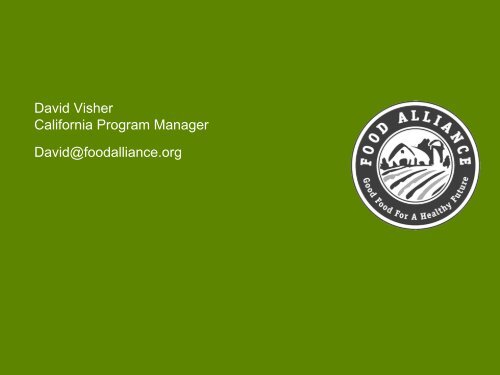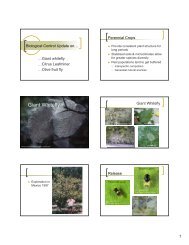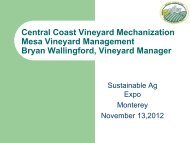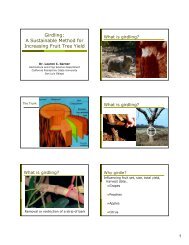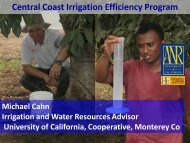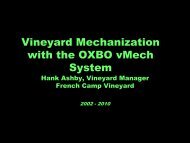Certified Sustainable by Food Alliance
Certified Sustainable by Food Alliance
Certified Sustainable by Food Alliance
You also want an ePaper? Increase the reach of your titles
YUMPU automatically turns print PDFs into web optimized ePapers that Google loves.
David Visher<br />
California Program Manager<br />
David@foodalliance.org
Sustainability?<br />
A sustainable food system . . .<br />
Economy<br />
Community<br />
Environment
Hot Topic: toxic pesticides<br />
• USEPA: $11 billion annually on 5 billion pounds of<br />
active ingredients -- 77% for use in agriculture<br />
• USEPA: Agriculture responsible for 70% of surface<br />
water pollution<br />
• Consumers Union: 40 common pesticides a direct<br />
threat to human health<br />
• USDA: Pesticide residues detected in 61% of fruits<br />
and vegetables.
Hot Topic: global warming<br />
• Agriculture is a source of methane (animals), nitrous<br />
oxide (tillage/fertilizer) and carbon dioxide (fossil<br />
fuels, land degradation)<br />
• The average meal is estimated to travel anywhere<br />
from 1500-2500 miles from farm to plate.<br />
• Transportation of food also requires energy<br />
expenditures for food processing, packaging, and<br />
refrigeration.
Hot Topic: social justice<br />
• Over 2 million farmworkers in US<br />
-- 75% earn less than $10,000/year<br />
• Farm work is one of the most dangerous<br />
occupations in US<br />
• Very few farmworkers have health coverage
Hot Topics: wildlife habitat<br />
• Agricultural expansion is the primary cause of habitat loss<br />
and fragmentation throughout the world.<br />
• Agriculture is implicated in the decline of 40% of<br />
endangered species.
Hot Topics: family farms<br />
• Consolidation in industry and thin margins create<br />
pressure to ‘get big or get out’<br />
• “Agriculture-of-the-middle” refers to a disappearing<br />
sector of mid-scale farms/ranches (account for over<br />
80% of U.S. farmland) who are unable to<br />
successfully market bulk commodities or sell food<br />
directly to consumers.
Locally Grown <strong>Food</strong>s<br />
Family Farms<br />
Labor Conditions<br />
Animal Welfare<br />
<strong>Sustainable</strong><br />
Agriculture<br />
Toxicity – Pesticides, etc<br />
Antibiotics & Hormones<br />
Genetic Engineering<br />
Soil and Water Conservation<br />
Wildlife Habitat
Industry Takes Action<br />
KP’s Vision for a Healthy <strong>Food</strong> System:<br />
“Kaiser Permanente aspires to improve the health of our<br />
members, employees, our communities and the<br />
environment <strong>by</strong> increasing access to fresh, healthy food<br />
in and around KP facilities. We will do so in a manner<br />
that promotes agricultural practices that are ecologically<br />
sound, economically viable, culturally appropriate and<br />
socially responsible.”
A Shift in Consumer Values<br />
Value<br />
• Quality<br />
• Convenience<br />
• Price<br />
New Values<br />
• Health<br />
• Community<br />
• Environmental<br />
Stewardship<br />
• Authenticity
Consumers Today<br />
“People want to know what lies behind a brand and<br />
the extent to which its values are aligned with their<br />
own… Today, the issue is what a brand says about<br />
someone, as a badge indicative of the individual’s<br />
values and view of the world.”<br />
Chris Pomfret, Unilever Marketing Executive<br />
KP’s National <strong>Food</strong> Purchasing and Labeling Guidelines: RFI/RFP
Eco-labels<br />
Reduced<br />
Pesticides<br />
Ecosystem<br />
Friendly<br />
Animal<br />
Friendly<br />
Socially<br />
Responsible<br />
<strong>Sustainable</strong>
Eco-Labels are Credible When They Are:<br />
• Meaningful and verifiable<br />
• Consistent and clear<br />
• Transparent<br />
• Independent and free from conflict of interest<br />
• Open to public comment<br />
Consumer’s Union<br />
www.greenerchoices.org/eco-labels/
Product claims & compliance mechanisms:<br />
• 1st party claim – Promise or affidavit<br />
• 2nd party claim – Endorsement with affidavit or<br />
inspection<br />
• 3 rd party claim – Inspection <strong>by</strong> a neutral party
<strong>Food</strong> <strong>Alliance</strong><br />
<strong>Food</strong> <strong>Alliance</strong> creates market incentives for socially<br />
and environmentally responsible agricultural<br />
practices and educates business leaders and other<br />
food system stakeholders on the benefits of<br />
sustainable agriculture.
<strong>Food</strong> <strong>Alliance</strong><br />
Operates a third-party certification program and a<br />
market development program to connect<br />
sustainable growers with food businesses.<br />
• Sets standards for sustainable agriculture<br />
• Verifies compliance with standards<br />
• Helps connect sellers and buyers of certified<br />
products
<strong>Food</strong> <strong>Alliance</strong> in a Snapshot<br />
• More than 300 farms and ranches in<br />
• 5.6 million acres of range and farm land<br />
• Nearly 20 food processing and distribution facilities<br />
• $100 million of FA certified products sold in 2007
<strong>Food</strong> <strong>Alliance</strong> <strong>Certified</strong><br />
Businesses that demonstrate their compliance<br />
with our standards are granted the right to use<br />
the eco-label on certified products.
<strong>Food</strong> <strong>Alliance</strong> certifies<br />
farms and ranches that:<br />
• Raise animals without synthetic hormones<br />
and non-therapeutic antibiotics<br />
• Provide healthy and humane treatment of<br />
animals<br />
• Raise crops without genetically modified<br />
organisms (GMOs)<br />
• Reduce pesticides usage and toxicity<br />
• Conserve soil and water resources<br />
• Preserve and protect wildlife habitat<br />
• Provide safe and fair working conditions<br />
• Commit to continuous improvement of<br />
these sustainable practices
<strong>Food</strong> <strong>Alliance</strong> certifies<br />
processors and distributors that:<br />
• Use <strong>Food</strong> <strong>Alliance</strong> <strong>Certified</strong> ingredients from sustainable farms and ranches<br />
• Provide a safe and fair work environment<br />
• Conserve water and energy resources<br />
• Reduce waste through reuse and recycling<br />
• Create natural products considering purity and nutritional value<br />
• Ensure quality control and food safety<br />
• Commit to continuous improvement of these sustainable practices
Certification Process<br />
1. Voluntary application<br />
2. On-site inspection <strong>by</strong> independent auditor<br />
3. Continuous improvement goals recorded<br />
4. Inspector writes detailed report on audit results<br />
5. <strong>Food</strong> <strong>Alliance</strong> shares determination with client<br />
6. If necessary, corrective actions required and verified<br />
7. Certification granted or denied
Who’s getting<br />
certified?<br />
• Individual farms & ranches<br />
• Producer groups, Co-ops<br />
• Processors/Manufacturers
www.foodalliance.org
What does certification cost?<br />
Farms and ranches pay annual fees based on the previous year’s gross sales of the products<br />
certified:<br />
Up to $175,000<br />
.5% of sales (or base price of $400, whichever is greater)<br />
Up to $300,000 Add .25% on sales over $175,000<br />
Over $300,000 Add .10% on sales over $300,000<br />
<strong>Food</strong> processors and manufacturers pay inspection costs plus annual fees on net sales of certified<br />
products:<br />
Up to $500,000<br />
.4% of sales<br />
Up to $2 million Add .2% on sales over $500,000<br />
Up to $50 million<br />
Add .04% on sales over $2 million<br />
Over $50 million<br />
Add .02% on sales over $50 million
Lesson Learned:<br />
People buy products – not labels
Lesson Learned:<br />
Certification verifies<br />
and substantiates claims<br />
• Traceability<br />
(What is the source?)<br />
• Transparency<br />
(What are the standards?)<br />
• Accountability<br />
(Have the standards been met?)
Lesson Learned:<br />
Certification is not for everyone
Lesson Learned:<br />
Certification is not<br />
just about price premiums
Lesson Learned:<br />
Certification is a tool<br />
that supports your brand<br />
and your marketing strategies
Producers benefit most when they:<br />
• Label their products<br />
• Get marketing assistance<br />
• Invest in promotional and educational materials<br />
• Create strong, ‘high-touch’ relationships with<br />
customers<br />
• Talk about their certification and what it means
Other Benefits:<br />
• Meet customer product specifications<br />
• Manage environmental risks<br />
• Manage regulatory risks<br />
• Manage marketing risk – “stay on the shelf”<br />
• Improve community relations<br />
• Protect and enhance brands<br />
• Differentiate products<br />
• Increase customer loyalty<br />
• Gain access to new markets<br />
• Gain access to contracts<br />
• Increase sales<br />
• Feel good <strong>by</strong> “doing the right thing”
Why choose certification?<br />
• Differentiate products and enter new markets<br />
• Brand the company as an industry leader<br />
• Address customer needs and values<br />
• Demonstrate company values


